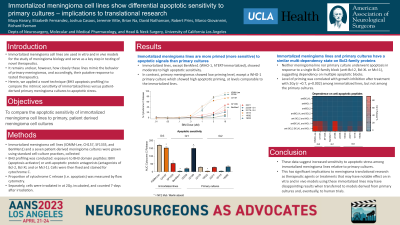Immortalized meningioma cell lines show differential apoptotic sensitivity to primary cultures – implications to translational research
Immortalized Meningioma Cell Lines Show Differential Apoptotic Sensitivity to Primary Cultures – Implications to Translational Research
Friday, April 21, 2023


Maya Harary, MD
Resident
University of California, Los Angeles
Los Angeles, California, United States
ePoster Presenter(s)
Introduction: Immortalized meningioma cell lines are used in vitro and in vivo models for the study of meningioma biology, and serve as a key step in testing of novel therapeutics. It remains unclear, however, how closely these lines mimic the behavior of primary meningiomas, and accordingly, their putative response to tested therapeutics. Herein, we applied a novel technique (BH3 profiling) to compare the intrinsic sensitivity of immortalized lines versus patient-derived primary meningioma cultures to apoptotic stress.
Methods: Immortalized meningioma cell lines (IOMM-Lee, CH157, SF1335, and BenMen1) and a five patient-derived meningioma cultures were grown using standard cell-culture practices, collected, and subsequently exposed to BH3 domain peptides: BIM (apoptosis activator) or anti-apoptotic protein antagonists (antagonists of Bcl-2, Bcl-XL and or Mcl-1). Cells were then fixed and stained for cytochrome C. Proportion of cytochrome C release (i.e. apoptosis) was measured by flow cytometry. Separately, cells were irradiated in at 2Gy, incubated, and counted 7-days after irradiation.
Results: Immortalized lines, except BenMen1 (WHO-1, hTERT-immortalized), showed moderate to high apoptotic sensitivity. In contrast, primary meningiomas showed low priming level, except a WHO-1 primary culture which showed high apoptotic priming, at levels comparable to the immortalized lines. Neither meningioma line nor primary culture underwent apoptosis in response to a single Bcl2-family block (anti-Bcl-2, Bcl-XL or Mcl-1), suggesting dependency on multiple apoptotic blocks. Level of priming was correlated with growth inhibition after treatment with 2Gy (r =0.7, p=0.002) among immortalized lines, but not among the primary cultures.
Conclusion : These data suggest increased sensitivity to apoptotic stress among immortalized meningioma lines relative to primary cultures. This has significant implications to meningioma translational research as therapeutic agents or treatments that may have notable effect on in vitro and in vivo models using these immortalized lines may have disappointing results when transferred to models derived from primary cultures and, eventually, to human trials.
Methods: Immortalized meningioma cell lines (IOMM-Lee, CH157, SF1335, and BenMen1) and a five patient-derived meningioma cultures were grown using standard cell-culture practices, collected, and subsequently exposed to BH3 domain peptides: BIM (apoptosis activator) or anti-apoptotic protein antagonists (antagonists of Bcl-2, Bcl-XL and or Mcl-1). Cells were then fixed and stained for cytochrome C. Proportion of cytochrome C release (i.e. apoptosis) was measured by flow cytometry. Separately, cells were irradiated in at 2Gy, incubated, and counted 7-days after irradiation.
Results: Immortalized lines, except BenMen1 (WHO-1, hTERT-immortalized), showed moderate to high apoptotic sensitivity. In contrast, primary meningiomas showed low priming level, except a WHO-1 primary culture which showed high apoptotic priming, at levels comparable to the immortalized lines. Neither meningioma line nor primary culture underwent apoptosis in response to a single Bcl2-family block (anti-Bcl-2, Bcl-XL or Mcl-1), suggesting dependency on multiple apoptotic blocks. Level of priming was correlated with growth inhibition after treatment with 2Gy (r =0.7, p=0.002) among immortalized lines, but not among the primary cultures.
Conclusion : These data suggest increased sensitivity to apoptotic stress among immortalized meningioma lines relative to primary cultures. This has significant implications to meningioma translational research as therapeutic agents or treatments that may have notable effect on in vitro and in vivo models using these immortalized lines may have disappointing results when transferred to models derived from primary cultures and, eventually, to human trials.
